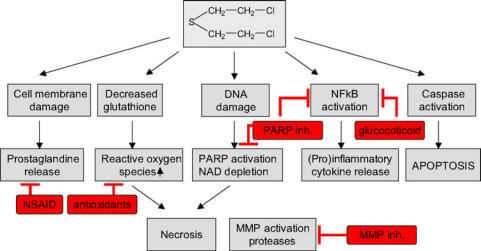Figure 3.
Pathways implicated in sulfur mustard-induced pathophysiology and possible targets (red) for therapeutic intervention. Sulfur mustard-induced direct and indirect (reactive oxygen species) DNA damage lead to polymerase (PARP) activation and nicotine adenine dinucleotide (NAD) depletion, which may result in necrotic cell death. Sulfur mustard exposure has also been demonstrated to activate the extrinsic and intrinsic pathway of apoptosis. Sulfur mustard-induced release of (pro)inflammatory cytokines has been linked to NFkB activation and prostaglandine release. Sulfur mustard has also been shown to upregulate matrix metalloproteases and serin proteases. The exact signal transduction for matrix metalloproteinase (MMP) activation has not been identified yet. In conclusion, PARP inhibitors, anti-inflammatory drugs, antioxidants, and MMP inhibitors are identified as promising pharmacological approaches to improve clinical outcome.

